North Dakota’s Child Care System: Investments Needed to Support Families and Child Care Businesses
December 2022
Child care is a critical component of a modern and thriving economy. High-quality and affordable care is essential for parents to stay in the workforce. Businesses across all sectors need workers who have a safe and reliable place for their children during the day. The coronavirus pandemic highlighted how important child care is and the complex challenges the system faces across the country. Child care businesses operate on narrow profit margins, often struggle to pay fair wages, and have high staff turnover. However, this long undervalued industry played a key role in reopening, allowing businesses to recruit and retain workers.
Even before the pandemic, families struggled to pay for child care in North Dakota.Families paid between $7,000 and $8,700 on average for child care in 2016, as expensive as the cost of in-state tuition at a four-year public college.1,2 Affordability has not improved. In 2021, families paid between $7,800 and $9,800 on average for child care.3
Since 2020, North Dakota has made strides to address the child care crisis using both federal relief money as well as state investments. North Dakota received more than $130 million in federal relief money to support child care and early childhood education.4 State policymakers invested an additional $17 million in flexible American Rescue Plan Act funds to support the child care system.5 During the 2021 legislative session, policymakers passed a pilot program to fund 4-year-old classrooms through 2025, investing $5.5 million over two years.6 These additional investments have meant more families are eligible for child care assistance, child care businesses have received grants to stabilize their operating expenses, and child care workers have received stipends to supplement wages.
These investments in the child care system have made a difference. An additional 450 families have accessed child care assistance since eligibility was expanded in early 2022.7 In the past year, the number of child care providers across the state has stayed about the same.8 However, despite the influx of investment in child care, many of the same challenges exist for families and child care businesses from before the pandemic. Wages for child care workers have not improved, and even decreased between 2020 and 2021.9 The cost of child care is still out of reach for many families with the average cost of child care increasing between 2020 and 2021.3,10 Continued and ongoing investment in the child care system is needed to sustain any wins made over the last three years and continue building a child care system that works for families, child care providers, and businesses all across the state. This report provides an analysis of the state of child care in North Dakota and offers the following recommendations to improve access to affordable, quality child care:
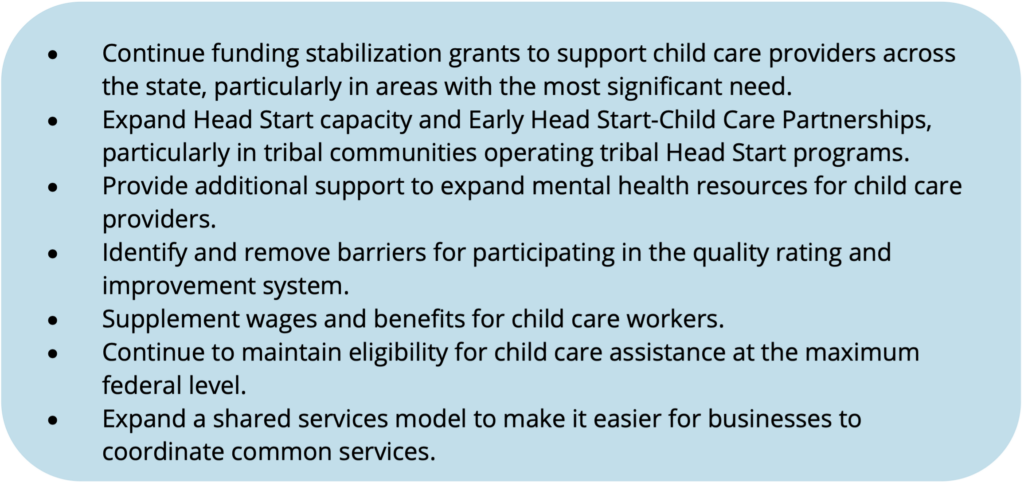
Access: Some Counties Lack Enough Child Care and Early Education Slots
About 62,000 children younger than age 6 call North Dakota home, and more than 70 percent of these children have all parents in the workforce.11,12 Children younger than age 6, particularly those with all parents working, likely need some type of child care before attending school. Additionally, there are more than 62,000 school-age children in North Dakota (age 6 through 11), thousands who require before or after school care.11
Child care and early education occurs in a variety of settings. In 2022, North Dakota had an estimated supply of licensed child care and early education slots for 37,749 children. Child care supply is estimated from licensed child care facilities (35,055) and Head Start enrollment (2,694). Missing from this count of child care supply are providers registered or certified with the state or providers licensed with a tribal entity.13 North Dakota offers a voluntary registration or certification to providers that have five or fewer children in their care or are part of a tribal agency, however, capacity for these programs is no longer tracked. While school-age children can attend licensed or registered child care programs, there are an additional 47 school-age programs that provide 3,782 slots for children age 6 to 11.13
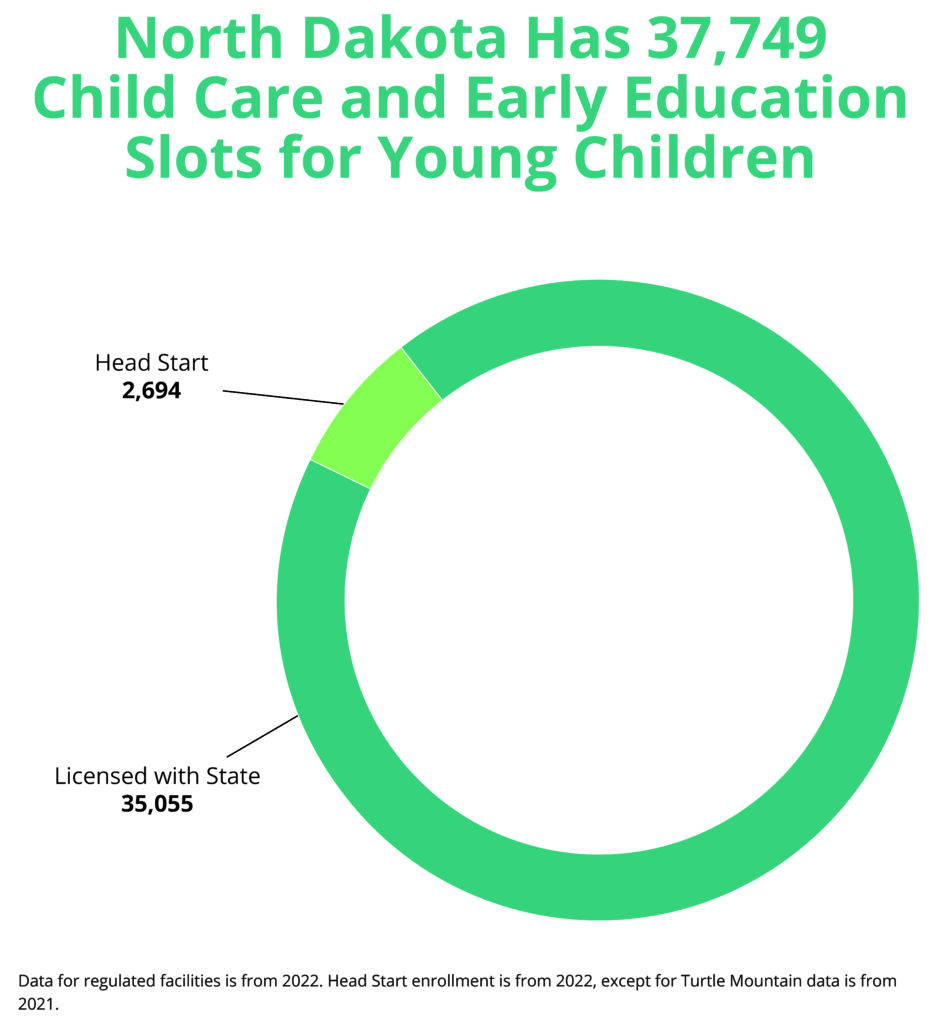
The current supply of child care and early education slots is short of the demand for working families with children younger than age 6. In 2022, there was enough child care and early education supply for 81 percent of children younger than age 6 with all parents working.14 Certain areas of North Dakota fall further behind on access to child care and early education. There are 20 counties that meet less than 60 percent of the demand for working families (Benson, Burke, Dunn, Eddy, Kidder, McKenzie, McLean, Mercer, Morton, Mountrail, Oliver, Renville, Rolette, Sargent, Sheridan, Sioux, Slope, Towner, Wells, Williams).15 Neighboring counties with supply that exceeds demand may help supplement the shortfall in some areas; however, this also means that families must travel to find child care. Fourteen of these counties experience both a low supply of child care or early education and either high poverty (Benson, Kidder, Oliver, Rolette, Sheridan, Sioux, Slope, Towner) or unemployment (Benson, Burke, Eddy, Kidder, McKenzie, Mercer, Rolette, Sheridan, Wells, Williams).16 These areas could benefit from additional child care supply to ensure families have access to care to return to work. Families seeking care for non-traditional hours may also struggle with access to care, with only 4 percent of licensed programs open during the weekends, 5 percent open during evenings, and 26 percent open during early morning hours.3
Using county boundaries to assess child care has limitations. Families may access care across county lines in some communities. Many counties also share boundaries with a tribal nation within North Dakota. Child care and early education slots in these areas may not exactly align with county-level reporting.
Tribal Head Start programs provide critical access to early childhood education for families living in reservation communities, offering evidence-based and culturally relevant early education to communities that have faced generations of limited access to social and economic resources because of discriminatory policies and decisions. Tribal nations within North Dakota operate tribal Head Start programs and collectively enrolled 736 children in 2022.17 On average, tribal Head Start programs provide care for 41 percent of children younger than age 6 with all parents working who live on one of the American Indian reservations within North Dakota.18 North Dakota also has Head Start programs not affiliated with a tribal nation. Head Start programs across the state provide access to early education for diverse families. Children of color make up the majority of Head Start enrollment (67 percent compared to 28 percent of the population in North Dakota), underscoring the importance of Head Start for communities of color.19,20
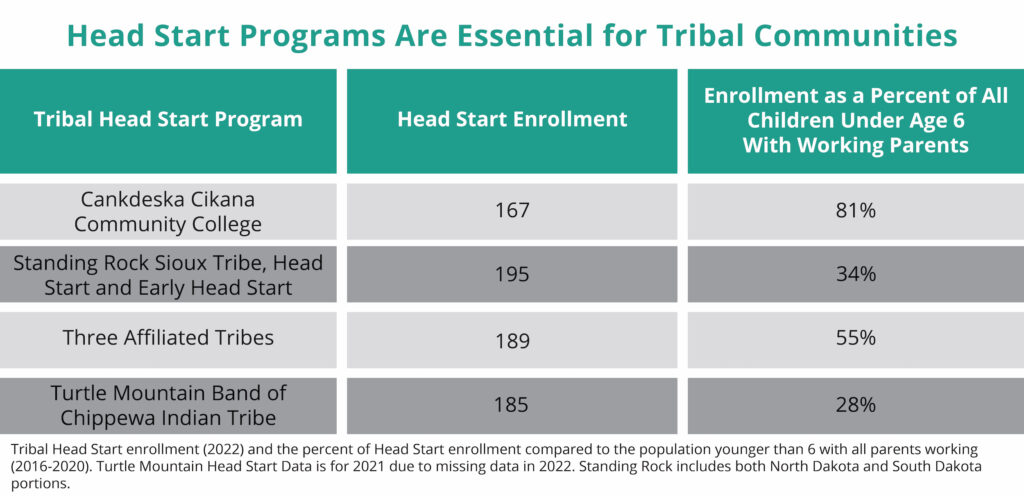
For communities already experiencing child care shortfalls, it is likely worse than these numbers indicate after adding in school-age children who need before or afterschool care. State-licensed school-age programs provide a slot for only 8 percent of children age 6 to 11 with all parents working.21 Other before or afterschool programs do exist that are exempt from state licensing requirements; however, comprehensive data on school-age programs is lacking in the state. Access to school-age care is limited in North Dakota. For every child attending an afterschool program, there are two more children waiting.22 Parents report that cost, lack of programs, and transportation are the top three barriers to finding out-of-school care for their children.22 School-age children are more likely to have all parents working (79 percent), underscoring the importance of school-age care for parents to stay in the workforce.12 Expanding school-age care also provides an opportunity to support the state’s future workforce. Afterschool and summer programs can help students gain news skills and learn about new interests or professions.23
While North Dakota meets the estimated demand for child care for children younger than age 6 in many counties across the state, some areas come up short. This includes certain high-poverty areas, care for families with school-age children, and care during non-traditional hours. In communities without enough child care, parents are left to make difficult decisions about how or if to return to work. This has been particularly evident during the pandemic, where mothers of young children left the labor force at a higher rate than women without children. Labor force participation for mothers with young children dropped 7 percentage points between 2019 and 2020 in the three-state region of Montana, North Dakota, and South Dakota.24 Inadequate child care impacts businesses. When workers cannot access child care, businesses experience lower productivity and struggle to recruit and retain workers.
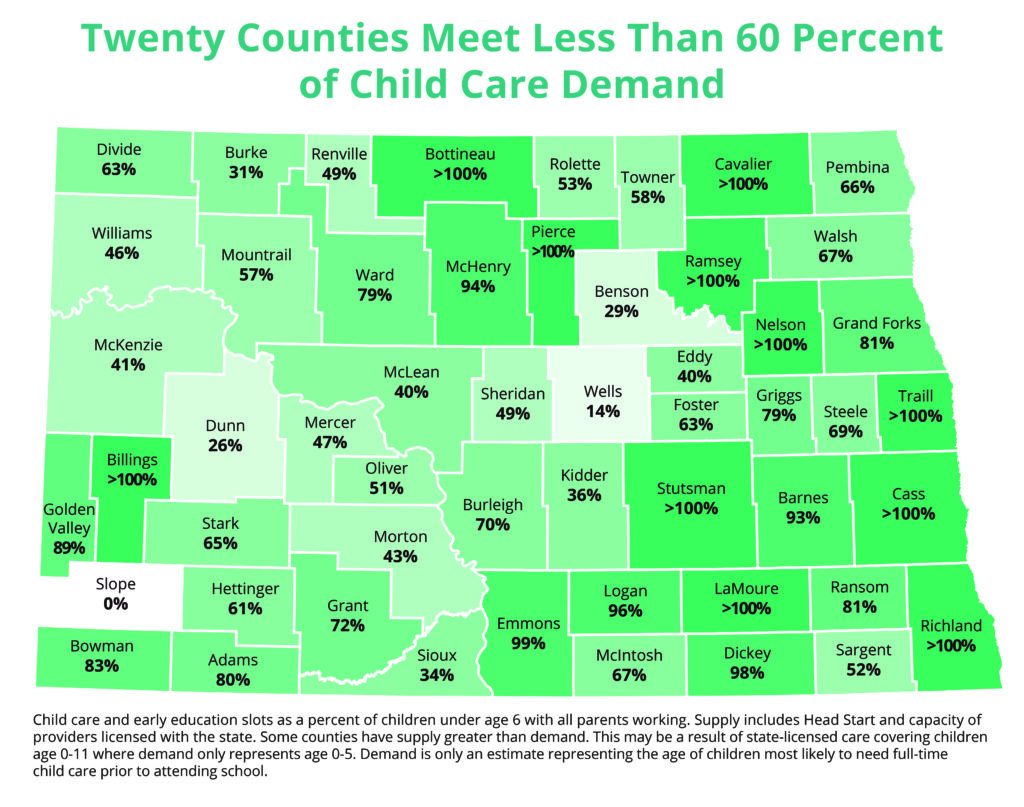
Quality: Not All Available Child Care Is High Quality
High-quality child care provides a safe and nurturing environment for children, involves their families, and creates a supportive environment for workers. Licensed facilities meet basic health and safety standards set by the state, establishing a baseline standard of care. Little is known about unlicensed facilities; however, they exist in North Dakota. The U.S. Economic Census records businesses that report income as child daycare services. More than 900 businesses report income from child care than are licensed, registered, or certified with the state.25
Child care facilities that provide high-quality care go above and beyond licensing requirements. Providers in North Dakota can participate in a voluntary quality rating and improvement system (QRIS, also called “Bright & Early ND”). Providers advance through four rating levels as they demonstrate improvement on health and safety standards, enriching learning environments and curriculum, and supportive relationships for children with their teachers and peers. A provider at QRIS level two begins receiving financial incentives to use for continued improvement.
A clear gap exists in the availability of high-quality child care. In North Dakota, the majority of licensed providers (82 percent) do not participate in QRIS.26 Child care providers must invest time and resources to offer high-quality programs, and it takes about nine months to move through one QRIS level. North Dakota needs solutions that encourage more providers to participate in QRIS in addition to ongoing support for current high-quality providers to maintain high standards of care.
Affordability: Parents Often Cannot Afford Child Care, and Child Care Businesses Struggle to Stay Open
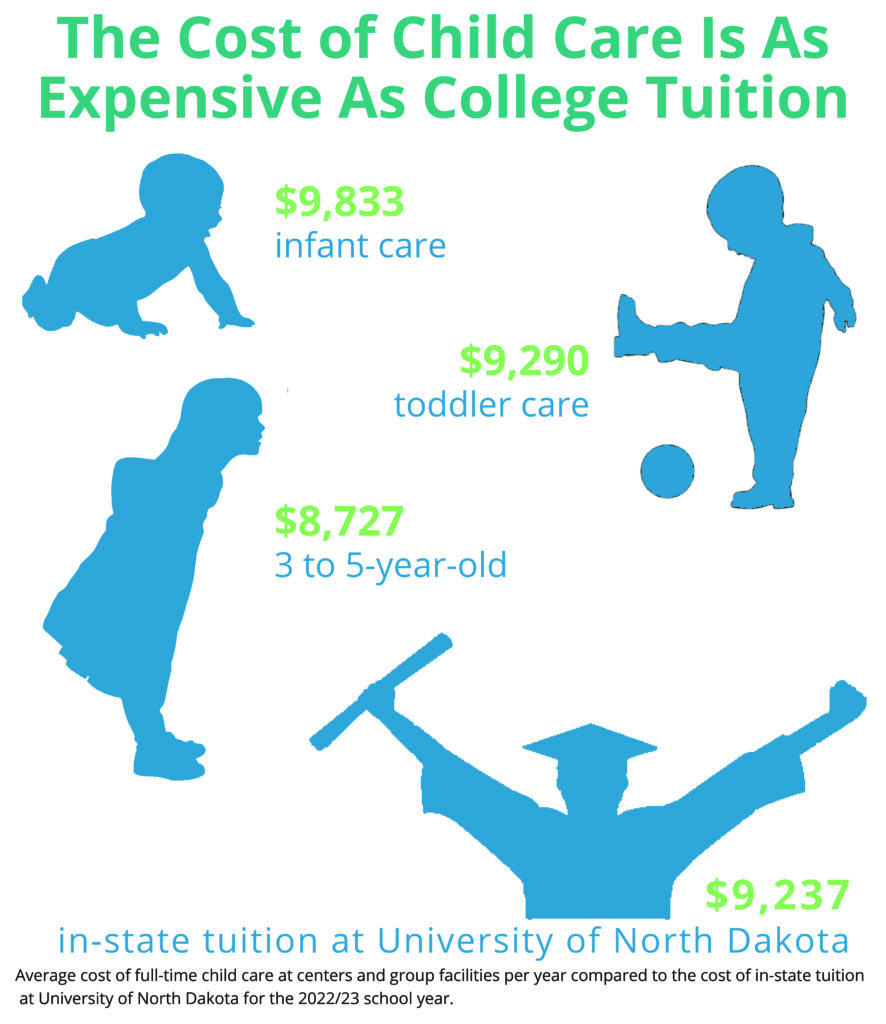
North Dakota families struggle to afford child care. On average, families pay between $7,800 and $9,800 per year for child care, as expensive as in-state tuition at a public university.3,27 This means a household making $64,300 spends between 12 percent and 15 percent of their income on child care.28 Child care is more expensive for younger children and at a center or group facility.
The federal Child Care Assistance Program provides money towards child care costs for families with lower incomes. In 2021, about 4,600 children received child care assistance.29 However, more eligible children could benefit from the program than are currently participating. Estimates from the U.S. Census Bureau show that during the same timeframe in 2021, at least 20,000 children younger than age 6 lived below the income guideline for eligibility.30 Starting in February 2022, North Dakota expanded eligibility for the Child Care Assistance Program and even more families are now eligible. For example, a family a three is eligible if they earn less than about $74,000 per year.31
Child care businesses must balance the true cost of providing high-quality care with what parents can afford. Because of this, many child care businesses operate on narrow margins and often cannot pay employees a fair wage. Employee wages and benefits make up more than half the cost for most child care businesses (67 percent for infants and 57 percent for toddlers and preschool-age), with other expenses going toward rent and utilities, administrative costs, and classroom materials.32
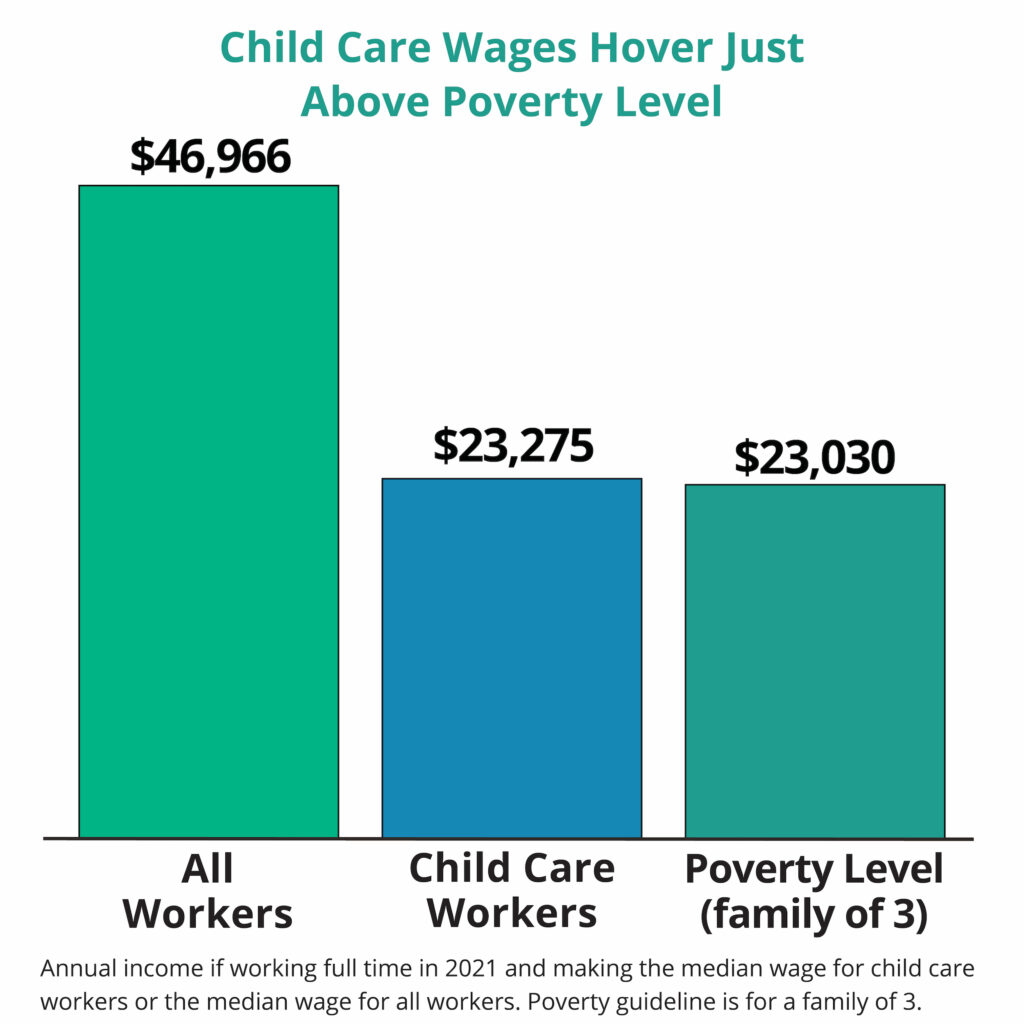
Low wages for child care workers leads to staffing instability, making it challenging for child care businesses to retain workers and remain open. In North Dakota, 5,659 individuals work in the early childhood field, about the same as the number of elementary school teachers in the state.3,33 Child care workers predominately identify as female (more than 90 percent) and 1 in 5 (19 percent) are workers of color.34 In North Dakota, the median wage for child care workers was $11.19 an hour in 2021, which means making $23,275 per year if working full-time.35 This is barely hovering above the poverty level for a family of three. Child care workers make less than half the wage of a kindergarten teacher.36
The child care system in North Dakota is in dire need of solutions that consider the cost of care for parents while providing adequate funding for child care businesses that continue to play a critical role in North Dakota’s economic recovery.
Recommendations
North Dakota needs innovative, long-term solutions to build a better child care system that works for children, parents, and businesses. As North Dakota considers a meaningful and significant investment in the child care system, policymakers should reimagine what child care can and should be in our state and invest in infrastructure and programs that set North Dakota up for long-term success. Specific recommendations include:
Access
- Continue funding stabilization grants to support child care providers across the state. Grants that prioritize areas with the most significant child care shortage ensure funds are distributed equitably.
- Providers in areas that fall short of the current demand, particularly those that also have high poverty or unemployment rates.
- Providers that serve historically marginalized communities, including children of color and children with special needs.
- Providers that offer non-traditional hours of service.
- Providers that serve school-age children.
- Contribute additional funds to expand Head Start slots and Early Head Start-Child Care Partnerships, particularly in tribal communities operating tribal Head Start programs. Head Start is an evidence-based program and is particularly essential for providing high-quality care in tribal communities. Investing additional funds in Head Start is a ready-built solution to reach more children in North Dakota. Other states have implemented this funding solution with success.37
Quality
- Provide additional support to expand the mental health resources for child care providers across the state. Equipping providers with the mental health training and resources they need will help support child care workers, families, and children.
- Remove barriers for participating in the quality rating and improvement system (QRIS). Conduct an assessment to identify the barriers to participation in QRIS. Understanding why more providers do not participate in QRIS is critical to finding solutions and increasing participation.Participating in QRIS may also be out of reach for facilities with fewer resources. This potentially widens inequities across the state where only the most well-funded programs participate in QRIS and are rewarded with additional incentives.38
Affordability
- Supplement the wages and benefits for child care workers. Child care workers are essential and deserve wages that reflect the value of their work. Yet, child care workers in North Dakota make wages near the poverty level making it hard to recruit and retain a trained workforce to care for children.
- Continue to maintain eligibility for child care assistance at the maximum federal level. Expanded eligibility has allowed 450 more families to access child care assistance. More families are eligible than currently participate. An outreach campaign to reach more families that are eligible but not currently receiving child care assistance can help more families afford child care. School-age children (up to age 13) and children with special needs (up to age 19) are eligible for child care assistance and would benefit from inclusion in an outreach campaign to eligible families.
- Implement a shared services model statewide to make it easier for businesses to coordinate common services such as accounting, insurance, benefits for employees, and a substitute pool. Shared services models help small child care businesses tap into pooled resources at a lower cost than obtaining them on their own.
Footnotes
- Child Care Aware of North Dakota, “State Child Care Profile Data 2016.”
- National Center for Education Statistics, Table 330.20 Average undergraduate tuition and fees and room and board rates charged for full-time students in degree-granting postsecondary institutions, by control and level of institution and state or jurisdiction: 2016-17 and 2017-18.
- North Dakota Department of Human Services, “State Child Care Profile Data 2021,” on file with author.
- Federal relief money for child care and early education came from three rounds of allocations: The Coronavirus Aid, Relief, and Economic Security (CARES) Act, Coronavirus Response and Relief Supplemental Appropriations (CRRSA) Act, and the American Rescue Plan Act (ARPA). Totals include money from state allocations, tribal allocations for tribal nations located within North Dakota (Spirit Lake Nation, Standing Rock Sioux Tribe, Three Affiliated Tribes/Mandan, Hidatsa & Arikara, Trenton Indian Service Area, and Turtle Mountain Band of Chippewa Indians), and Head Start allocations. CARES State Allocation: $6,037,905. U.S. Department of Health and Human Services Office of Child Care, “2020 CARES Act CCDBG Supplemental Funding Allocations for States and Territories,” Apr. 2020. CARES Tribal Allocation: $2,271,940. U.S. Department of Health and Human Services Office of Child Care, “GY 2020 CCDF Final Tribal Allocations,” July 2020. CRRSA State Allocation: $19,448,230. U.S. Department of Health and Human Services Office of Child Care, “Coronavirus Response and Relief Supplemental Appropriations Act (CRRSA) of 2021 Allocations for States and Territories,” Feb. 2021. CRRSA Tribal Allocation: $6,491,066. U.S. Department of Health and Human Services Office of Child Care, “Coronavirus Response and Relief Supplemental Appropriations Act (CRRSA) of 2021 Allocations for Tribes,” Feb. 2021. ARPA State Allocation: $75,760,496. U.S. Department of Health and Human Services Office of Child Care, “ARPA Supplemental Stabilization and CCDF Discretionary Funding Allocation Tables – States and Territories,” Apr. 2021. ARPA Tribal Allocation: $27,419,317. U.S. Department of Health and Human Services Office of Child Care, “ARPA Supplemental Stabilization and CCDF Discretionary Funding Allocation Tables – Tribes,” Apr. 2021. ARPA Head Start Allocation: $2,231,000. Federal Funds Information for States, “Estimated State Funding in the American Rescue Plan,” on file with author.
- North Dakota, 67th Legislative Assembly, SB 2345, enacted on Nov. 22, 2021.
- Rep. Robin Weisz, “Relating to establishing four-year old program grants,” HB 1466, North Dakota 67th Legislature, as introduced on Jan. 18, 2021.
- Kerns, E., North Dakota Department of Human Services, “RE: ARPA child care grant updates,” email to Xanna Burg, North Dakota KIDS COUNT, Sep. 22, 2022, on file with author.
- North Dakota Department of Human Services, “Monthly Provider Lists, Sep. 2021 through Sep. 2022,” on file with author. The number of providers went from 1,227 in Sep. 2021 to 1,216 in Sep. 2022.
- U.S. Bureau of Labor Statistics, Occupational Employment and Wage Statistics, May 2021 State Occupational Employment and Wage Estimates North Dakota, accessed on Aug. 24, 2022. U.S. Bureau of Labor Statistics, Occupational Employment and Wage Statistics, May 2020 State Occupational Employment and Wage Estimates North Dakota, accessed on Aug. 24, 2022. Median wage for a child care worker decreased from $11.61 in 2020 to $11.19 in 2021.
- Child Care Aware of North Dakota, “State Child Care Profile Data 2020,” on file with author.
- KIDS COUNT Data Center, Child population by single year of age, 2021.
- KIDS COUNT Data Center, Children with all available parents in the labor force by age, 2016-2020.
- State-licensed or registered providers: KIDS COUNT Data Center, Child care providers, by type, 2022. State-licensed capacity: KIDS COUNT Data Center, Child care capacity, by type, 2022. Head Start data: Office of Head Start, Head Start Program Information Report, 2022, on file with author. Head Start Program Information Report was not available for Turtle Mountain Band of Chippewa Indian Tribe’s Head Start in 2022, so 2021 numbers were added to reflect a more accurate count of Head Start enrollment.
- Includes slots that are licensed or are part of Head Start. School-age licensed capacity is not included. A total of 37,749 slots compared to the estimated demand of 46,361. Demand is estimated as the population younger than age 6 (62,355) multiplied by the percent of children younger than age 6 with all parents working (74.3 percent).
- Supply as a percent of demand for working families by county is calculated using: Supply: State-licensed capacity: KIDS COUNT Data Center, Child care capacity, by type, 2022. Head Start Enrollment: Head Start Program Information Report, 2022, on file with author. Note: Head Start enrollment is matched to a county at the program level due to data availability. Some Head Start programs operate sites across multiple counties and data will not exactly reflect each Head Start site. Data for Turtle Mountain Band of Chippewa Indian Tribe Head Start and matched to Rolette County is for 2021 data due to missing data in 2022. Demand: Population Age 0-5: KIDS COUNT Data Center, Child population by single year of age, 2021. Percent of children with all available parents working: KIDS COUNT Data Center, Children with all available parents in the labor force by age, 2016-2020. Note: The Standing Rock Sioux Tribe overlaps with both North Dakota (Sioux County) and South Dakota (Corson County). The child care and early education supply from Head Start includes slots located within South Dakota. Therefore, the estimated demand for Sioux County also includes the population for Corson County (489) in South Dakota.
- Supply is considered low if a county meets less than 60 percent of the demand from children age 0-5 with all parents working. Poverty is considered high if greater than or equal to 16 percent. Unemployment is considered high if greater than or equal to 4 percent. Cutoffs were chosen to reflect one quarter of counties scoring highest (poverty and unemployment) or lowest (supply). Poverty: KIDS COUNT Data Center, Children in poverty (1-year estimates), 2020. Unemployment: KIDS COUNT Data Center, Annual unemployment (all ages), 2021.
- Office of Head Start, Head Start Program Information Report, 2022, on file with author. Data for Turtle Mountain Band of Chippewa Indian Tribe Head Start and matched to Rolette County is for 2021 data due to missing data in 2022.
- Children needing care estimates (denominator of the percent) are from Census estimates at the American Indian Reservation geography. U.S. Census Bureau, “Age of Own Children Under 18 Years in Families and Subfamilies by Living Arrangements by Employment Status of Parents, American Community Survey 5-Year Estimates, Table B23008,” accessed on Nov. 17, 2022.
- Children of color include those identifying as American Indian or Alaska Native, Asian, Black or African American, Native Hawaiian or other Pacific Islander, Biracial/Multi-racial, other, or Latinx. Data from: Office of Head Start, Head Start Program Information Report, 2022. Data for Turtle Mountain Band of Chippewa Indian Tribe Head Start is for 2021 data due to missing data in 2022.
- U.S. Census Bureau, Population Estimates Program, Annual county resident population by single year of age (0-84,85+), sex, race (11), and Hispanic origin for April 1, 2020 (estimates base) and July 1, 2020-July 1, 2021 for North Dakota, on file with author.
- Includes slots that are state-licensed for school-age only. A total of 3,782 slots compared to the estimated demand of 49,646. Demand is estimated as the population age 6 to11 (62,685) multiplied by the percent of children age 6 to 17 with all parents working (79.2 percent).
- Afterschool Alliance, “North Dakota After 3PM,” accessed on Aug. 2, 2021.
- Afterschool Alliance, “Building Workforce Skills in Afterschool,” Nov. 2017.
- Boesch, T., Grunewald, R., Nunn, R., Palmer, V., “Pandemic pushes mothers of young children out of the labor force,” Federal Reserve Bank of Minneapolis, Feb. 2021.
- 992 more businesses reported income as day care services (2,598) than are licensed, registered, or certified with the state (1,606). Data includes businesses that report income as child day care services under NAICS code 6244. Employers, Individual Proprietorship, and Partnerships are all included. U.S. Census Bureau, “Nonemployer Statistics for the U.S., States, Counties, Metropolitan Areas, and Combined Statistical Areas; and by Legal Form of Organization and Sales, Value of Shipments, or Revenue, U.S. Economic Annual Survey, 2019,” accessed on Nov. 17, 2022. U.S. Census Bureau, “County Business Patterns by Legal Form of Organization and Employment Size Class for the U.S., States, and Selected Geographies, U.S. Economic Annual Survey, 2019,” accessed on Nov. 17, 2022. Licensed, registered, or certified facilities in North Dakota in 2019 is from: KIDS COUNT Data Center, Child care providers, by type, 2019.
- KIDS COUNT Data Center, Child care providers, by quality rating, 2022.
- Estimates for a ND resident undergraduate tuition during the 2022/23 school year is $9,237 at UND and $9,309 at NDSU. University of North Dakota, Estimate Your Tuition and Fees, accessed on Nov. 17, 2022. North Dakota State University, Undergraduate Tuition Rates and Student Fees – Fall 2022, Spring & Summer 2023, accessed on Nov. 17, 2022.
- The median household income in North Dakota. KIDS COUNT Data Center, Median household income, 2020.
- KIDS COUNT Data Center, Child care assistance recipients ages 0 to 13, 2021.
- Eligibility for the Child Care Assistance Program depends on household size and ranges from 187 percent to 236 percent of the federal poverty level. Estimates from the Census for less than 200 percent of the federal poverty level are used as the closest cutoff, which means this number may underestimate the true eligibility. U.S. Census Bureau, “Age by Ratio of Income to Poverty Level in the Past 12 Months, American Community Survey 5-Year Estimates, Table B17024, 2016-2020,” accessed on Nov. 18, 2022. Population estimates are multiplied by poverty percentage.
- North Dakota Department of Human Services, Child Care Assistance Program, accessed on Nov. 18, 2022.
- Estimates are for center-based child care. Center for American Progress, “Where Does Your Child Care Dollar Go?,” Feb. 2018.
- There are an estimated 5,440 elementary school teachers in North Dakota, including kindergarten teachers and special education teachers. U.S. Bureau of Labor Statistics, Occupational Employment and Wage Statistics, May 2021 State Occupational Employment and Wage Estimates North Dakota, accessed on Aug. 24, 2022.
- Percentages calculated using only valid responses. North Dakota Growing Futures, Workforce Demographics – 3rd Quarter 2022, accessed on Nov. 17, 2022.
- U.S. Bureau of Labor Statistics, Occupational Employment and Wage Statistics, May 2021 State Occupational Employment and Wage Estimates North Dakota, accessed on Aug. 24, 2022.
- The equivalent hourly wage for kindergarten teachers was $30.61 in 2019 compared to $11.44 for a child care worker. Center for the Study of Child Care Employment, “Early Childhood Workforce Index 2020,” Feb. 2021.
- National Head Start Association, “State Investments in Head Start to Support At-Risk Children and Families,” Dec. 2020.
- Center for the Study of Child Care Employment, “Early Childhood Workforce Index 2020.”

